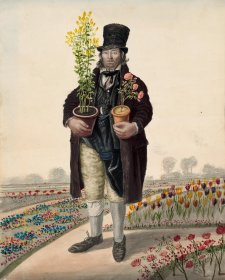The sand-man with his donkey, its panniers filled, crying ‘Sand — oh!’ or ‘Lily-white sand!’, was a familiar figure in Georgian cities and towns, from the eccentric Thomas Bodfish of Wellingborough, Northamptonshire, known for his celebrated performing donkey and ‘niddle-noddle’ song to the lovestruck tradesman of the Cockney ballad The rat-catcher’s daughter. Fine sand was as necessary a domestic article as it was commonplace. Like reeds or straw, it would be spread over rough earth or brick floors in order to absorb dirt, mud and spills; it was particularly in demand in taverns and kitchens, where it also served as a scouring agent for pots and pans. The trade declined towards the middle of the 19th century, however, ‘saw-dust having greatly superseded it in the gin-palace, the tap-room, and the butcher’s shop’.
While the expression of this Yorkshire sand-man is rather dour, his trade does inevitably prompt speculation around the phrase ‘happy as a sand-boy’. Several exchanges in the 19th century antiquarian’s bible Notes and Queries ventured explanations for the phrase ranging from sand fleas to drinking, but ‘without eliciting a satisfactory answer’. What seems most likely is that the first use of the phrase was by Pierce Egan in Life in London (1821), and that it came into general usage simply as a result of the phenomenal popularity of that book, both in print and on stage. Egan describes how, when visiting the All Max public house in the East End, his character Bob Logic ‘appeared as happy as a sand-boy, who had unexpectedly met with good luck in disposing of his hampers full of the above household commodity in a short time, which had given him a holiday …’. John Badcock’s Slang …, which appeared just a couple of years later, claimed that ‘“As jolly as a sandboy,” designates a merry fellow who has tasted a drop’.
It may be that Dempsey’s choice of the Whitby sand-man as his recognisable ‘character’ for that locale relates to the town’s topography. From the sandy shoreline at the mouth of the river Esk, a famous set of 199 steps rises steeply to St Mary’s church and Whitby Abbey at the top of the cliff; alongside the stair is a graded cobbled path called Church Lane, but known locally as the Donkey Path. This may have been the local sand-man’s supply route.
Collection: Tasmanian Museum and Art Gallery, presented by C. Docker, 1956



Dempsey’s People curator David Hansen chronicles a research tale replete with serendipity, adventure and Tasmanian tigers.



Dempsey’s people: a folio of British street portraits 1824–1844 is the first exhibition to showcase the compelling watercolour images of English street people made by the itinerant English painter John Dempsey throughout the first half of the nineteenth century.



Visit us, learn with us, support us or work with us! Here’s a range of information about planning your visit, our history and more!